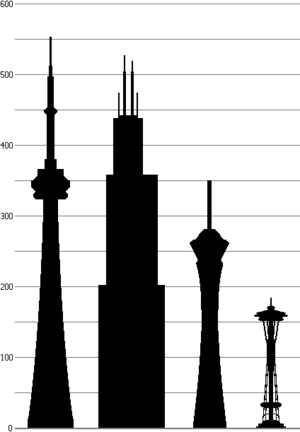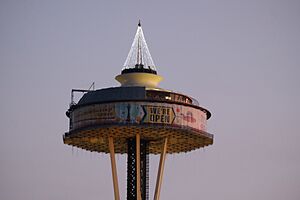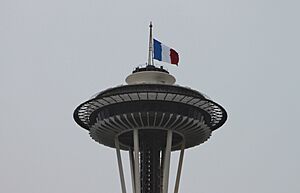Space Needle facts for kids
Quick facts for kids Space Needle |
|
|---|---|
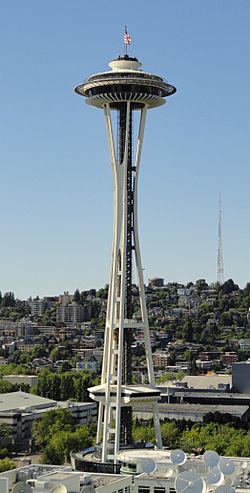
The Seattle Space Needle in 2011
|
|
| Record height | |
| Tallest in Seattle and Washington state from 1962 to 1969 | |
| Preceded by | Smith Tower |
| Surpassed by | Safeco Plaza |
| General information | |
| Status | Complete |
| Type | Observation tower / Gyro tower |
| Address | 400 Broad Street Seattle, Washington 98109 |
| Coordinates | 47°37′13″N 122°20′57″W / 47.6204°N 122.3491°W |
| Construction started | April 17, 1961 |
| Completed | December 8, 1961 |
| Opening | April 21, 1962 |
| Owner | Space Needle Corporation |
| Height | |
| Antenna spire | 605.00 ft (184.404 m) |
| Top floor | 518 ft (158 m) |
| Technical details | |
| Floor count | 6 |
| Lifts/elevators | 3 |
| Design and construction | |
| Architecture firm | John Graham & Company |
| Structural engineer | John K. Minasian Victor Steinbrueck |
| Main contractor | Howard S. Wright Construction Co. |
| Designated: | April 19, 1999 |
The Space Needle is a super tall observation tower in Seattle, Washington, USA. It's a famous symbol of the city and is even a special Seattle landmark. You can find it in the Lower Queen Anne area. It was built for the 1962 World's Fair, which was a huge event that brought over 2.3 million visitors to Seattle.
Standing at 605 ft (184 m) high, the Space Needle was once the tallest building west of the Mississippi River. The tower is 138 ft (42 m) wide and weighs a massive 9,550 short tons (8,660 metric tons). It's built to be super strong, able to handle winds up to 200 mph (320 km/h) and earthquakes as powerful as 9.0 magnitude.
Fast elevators whisk visitors up to an observation deck 520 ft (160 m) above the ground in just 41 seconds. From there, you get amazing views of downtown Seattle, the Olympic and Cascade Mountains, Mount Rainier, Mount Baker, Elliott Bay, and many islands in Puget Sound. On April 19, 1999, the city officially named the Space Needle a historic landmark.
Contents
Space Needle Design and Structure
The Space Needle's unique look came from ideas by two people: Edward E. Carlson and John Graham, Jr. Carlson first sketched a giant balloon tied to the ground. Graham imagined a flying saucer for the restaurant and observation deck. Victor Steinbrueck added the tower's hourglass shape and its three-legged base. This design helps it stand strong, like the narrow piece of land Seattle sits on.
The Space Needle was built to survive very strong winds, even 200 mph (320 km/h) winds. This was twice as strong as the building rules required back in 1962. It only sways about 1 inch (25 mm) for every 10 miles per hour (16 km/h) of wind. In 2001, a 6.8 magnitude earthquake shook Seattle. The Space Needle handled it well, showing its strong design. It can avoid serious damage in earthquakes up to 9.1 magnitude.
For many years, the spinning disk at the top had two restaurants 500 ft (150 m) up. These were replaced by a new restaurant called SkyCity in 2000, which closed in 2017. In 1993, the old elevators were updated with new, faster ones. These new elevators travel down at 10 mph (16 km/h).
On December 31, 1999, a powerful light beam was turned on for the first time. It's called the Legacy Light or Skybeam. This beam uses lamps that shine with 85 million candela (a measure of light) straight up into the sky. It lights up for special holidays and events in Seattle. The idea for this beam came from a poster for the 1962 World's Fair.
The main staircase inside the Space Needle has 848 steps. These steps go all the way from the basement to the top observation deck. When it was built, the Space Needle was the tallest building west of the Mississippi River. Today, other buildings in Seattle, like the Columbia Center at 967 ft (295 m), are taller. Unlike some other tall towers, the Space Needle is not used for broadcasting radio or TV signals.
History of the Space Needle
Building the Space Needle
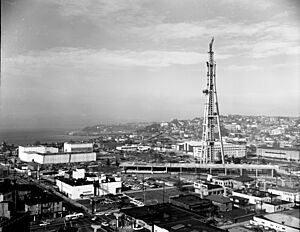
Edward E. Carlson, who was in charge of the 1962 World's Fair in Seattle, had an idea for a tall tower with a restaurant. He was inspired by a tower he saw in Germany. Architect John Graham joined the project. Graham changed the restaurant's design to make it spin, like one he had designed before. People suggested names like "Space Needle," "Star Tickler," and "Top Hat."
Finding the right spot for the Space Needle was tricky. Since the city didn't pay for it, land had to be bought. In 1961, they found a 120 by 120 ft (37 by 37 m) plot of land that held fire and police alarm equipment. The city sold this land for $75,000. Engineers quickly checked the site and said it was good for building. Only one year was left before the World's Fair started!
The Space Needle was built by a private group of investors. The concrete base is 30 ft (9.1 m) deep and 120 ft (37 m) wide. It took 467 concrete trucks a whole day to fill it. This foundation weighs 5,850 short tons (5,310 metric tons), which is the same as the tower above ground. The tower is held to the foundation by 72 bolts, each 30 ft (9.1 m) long.
Workers built the Space Needle day and night to finish on time. The round top, with its restaurants and observation deck, was perfectly balanced. A small electric motor, originally 0.8 kilowatts (1.1 hp), made the restaurant rotate. The tower was painted in fun colors: Orbital Olive for the body, Astronaut White for the legs, Re-entry Red for the saucer, and Galaxy Gold for the roof.
The Space Needle was finished in less than a year, costing $4.5 million. It opened in April 1962, just before the World's Fair. During the Fair, almost 20,000 people rode to the Observation Deck every day. In total, 2.56 million visitors came. When it was done, the Space Needle was the tallest building west of the Mississippi River.
Giant Bells of the Space Needle
During the World's Fair, a special instrument called a "Carillon Americana" was installed. It played recordings of 538 bells, making it the largest in the world at the time. You could hear the bells all over the fairgrounds and up to ten miles (16 km) away! The person playing the bells sat in a glass room at the base of the Needle. After the fair, the carillon was taken apart.
Life After the World's Fair
In 1963, a radio broadcast studio was built on the observation level. Radio stations used it for morning shows for many years. In 1974, a radio DJ even lived in an apartment next to the studio for six months!
On March 27, 1964, the restaurant at the top of the Space Needle stopped spinning. This happened because of a huge 9.2 magnitude earthquake in Alaska.
In 1974, a children's book called Wheedle on the Needle was published. It told the story of a furry creature named the Wheedle who lived on top of the Space Needle. The Wheedle became a popular character in Seattle. It even became the mascot for the Seattle SuperSonics basketball team, who played nearby.
In 1982, a new level called SkyLine was added 100 ft (30 m) up. This level was part of the original plans but wasn't built until later. Today, the SkyLine Banquet Facility is used for events and parties.
On April 19, 1999, the Space Needle was named a city historic landmark. This was 37 years after it first opened. Between 1999 and 2000, the Space Needle had big renovations. These included new lighting, a new SkyCity restaurant, and updates to the Observation Deck.
Every New Year's Eve, the Space Needle hosts an amazing fireworks show at midnight. Thousands of people watch from the Seattle Center grounds. The show is also shown on TV. In 2020, the fireworks were replaced by a light show because of strong winds. In 2021, an augmented reality show was broadcast instead due to the COVID-19 pandemic. The fireworks returned for 2022, but the grounds were closed to the public.
In May 2007, the Space Needle welcomed its 45 millionth visitor! Greg Novoa from California received a free trip to Paris. In May 2008, the Space Needle got its first professional deep cleaning since 1962. Workers pressure washed the monument at night so it could stay open during the day.
Big Anniversaries and Cool Upgrades
For its 50th anniversary in April 2012, the Space Needle's roof was painted "Galaxy Gold." This is an orangish color, just like when it was first built for the 1962 World's Fair. This special paint job was temporary. The Space Needle has been painted many times for different events. It had the University of Washington football team logo, and was painted for the game show Wheel of Fortune. It also showed colors for the Seattle SuperSonics and Seattle Mariners sports teams. The Galaxy Gold paint returned for the 60th anniversary in May 2022.
A big renovation of the Space Needle's top started in 2017. This project, called the Century Project, added a cool all-glass floor to the restaurant. It also replaced the observation deck windows with huge floor-to-ceiling glass panels. This made the views even better, matching the original ideas from 1962. The project also updated the tower's internal systems.
This $100 million project was finished by August 2018. The new space reopened as the Loupe, an indoor observation deck with a revolving glass floor. It takes 45 minutes for the deck to make one full spin. Two new staircases, called the Oculus Stairs, connect the two new levels. They are named after a glass circle at their base where you can see the elevators moving up and down. A café, a wine bar, and more restrooms were also added.
More renovations happened in 2025. These included a revolving glass floor in the restaurant and new glass on the observation decks. The first of three new double-deck, floor-to-ceiling glass elevators was also installed. These upgrades aim to give visitors even bigger, panoramic views from the top and from the elevators. The other two elevators are planned to be replaced in 2027 and 2028.
Flags Flying High
The top of the Space Needle often flies a large flag for holidays and special events. These flags are 25 by 35 feet (7.6 by 10.7 m) big. The flag of the United States is displayed on many national holidays. It is also lowered to half-staff when important people pass away or for major events.
Flags of local sports teams are raised when they win championships or have big games. For example, during Super Bowl XLVIII, fireworks were launched from the Space Needle for every touchdown scored by the Seattle Seahawks.
The Pride flag is displayed every June for Pride Month. It was first raised in 2010. In 2013, a special marriage equality flag was used. Since 2020, the Progress Pride flag has been flown.
The flag of France was raised at half-staff in November 2015. This showed support for the victims of the Paris attacks. In July 2020, a "Mask Up" flag was raised to remind people about face mask rules during the COVID-19 pandemic. On August 16, 2025, the flag of India was raised to celebrate the country's 79th Independence Day.
Amazing Jumps from the Tower
Six parachutists have jumped from the Space Needle since it opened. This sport is called BASE jumping. It is only allowed with special permission. Four jumpers were part of an authorized event in 1996. One of them broke a bone during the stunt. The other two jumped without permission and were arrested.
Space Needle in Movies and TV
The Space Needle is a famous symbol of the Pacific Northwest. It has appeared in many movies, TV shows, and other stories. Often, seeing the Space Needle in a show quickly tells you that the story is happening in Seattle.
Some TV shows where it appears include Frasier, Grey's Anatomy, Dark Angel, and Bill Nye the Science Guy. Movies like It Happened at the World's Fair (1962), Sleepless in Seattle (1993), and Chronicle (2012) also feature it. In the 1999 film Austin Powers: The Spy Who ... Me, the villain Doctor Evil's base was shown on top of the Space Needle, mixed with a famous coffee shop logo.
The Space Needle has also been part of logos for professional sports teams. These include the NBA's Seattle SuperSonics, the WNBA, MLS, and the NHL.
Sometimes, the Space Needle is used in practical jokes, especially on April Fools' Day. In 1989, a TV show reported that the Space Needle had collapsed, causing people to panic. In 2015, a radio station joked that a group called the "Borg Collective" wanted to build a cube around the landmark.
The Space Needle has also been shown in fictional disaster scenarios. In Life After People, it collapses after 200 years due to rust. In the miniseries 10.5, it crumbles during a 7.9 earthquake. However, the real Space Needle is made of steel and built to withstand much stronger earthquakes. The Space Needle was also the location for a challenge in the finale of The Amazing Race 35, where contestants walked on its roof.
The Space Needle is featured in the HBO series The Last of Us. It appears as a watchtower in a post-apocalyptic Seattle. It played a similar role in the video game The Last of Us Part II, which the TV series is based on.
Images for kids
See also
 In Spanish: Space Needle para niños
In Spanish: Space Needle para niños
- Näsinneula, a similar-look tower in Tampere, Finland
- Sydney Tower, a similar-look tower in Sydney, Australia
- Skylon Tower, a similar-look tower in Niagara Falls, Ontario
- List of tallest buildings in Seattle
- List of towers


